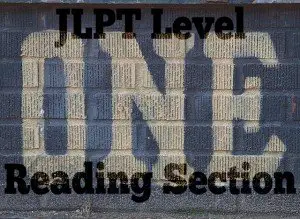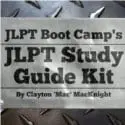 This is a special podcast that just covers JLPT N1 Reading Section, so if you are not studying for the JLPT N1 then you might want to check out my other podcasts in the series. There are podcasts for N5 Reading, N4 Reading, N3 Reading, and N2 Reading. Check them out and let me know what you think.
This is a special podcast that just covers JLPT N1 Reading Section, so if you are not studying for the JLPT N1 then you might want to check out my other podcasts in the series. There are podcasts for N5 Reading, N4 Reading, N3 Reading, and N2 Reading. Check them out and let me know what you think.
What the N1 Reading Section Looks Like
The N1 Reading Section has a total of 26 questions. This level actually has all 6 types of questions that are present on the other exams. It starts off with 4 short passage questions (~200 characters, 1 passage/1 question). Then, it moves on to 9 medium passage questions (~500 characters, 3 passages/3 questions). Both of these types of questions cover relatively easy passages that cover descriptions, directions, reviews, commentary, and essays.
After the short and medium passages, there are 4 long passage questions (~1000 characters, 1 passage/4 questions). This long passage is will be a commentary, essay or novel (short story). Next, there are 3 integrated comprehension questions (~600 characters, 1 passage/3 questions). These questions involve reading 2 or 3 related passages and then answering questions on the similarities and differences between the passages.
After all that, there are 4 thematic comprehension questions (~1000 characters, 1 passage/4 questions). These questions are very similar to the long passage questions before, but the essay will be more abstract and logical. It will most likely be an editorial or review.
To finish this whole section off, there are 2 information retrieval questions (~700 characters, 1 passage/2 questions). The information retrieval questions cover brochures, advertisements, magazines and business documents.
N1 Reading Tactics
For the first two types of questions, the tactics are relatively straightforward. Read the question first then do the reading. This way you know what the main idea of the passage is and what to pay attention to. These first two questions will want to know about details, so be careful and check the wording of each answer.
The two ~1000 character sections (the long passage and the thematic passage) are a little different. You should still read the questions before reading the passage, but this time it is important to read the passage a little more quickly. Still be on the look out for details, but they will be testing you over general ideas more than details.
The long passage questions will usually ask about references, for example ‘それとは、何か?’, what is ‘sore’? This will usually refer to a summarized idea from the sentences preceding it and not an exact word that was mentioned in the text.
The thematic passage is a little different. This passage will be more abstract and logical. The questions will revolve more around what the author is trying to say and other inference (reading beyond the words) questions. This is where the tactics I mention in the free guide will really help.
In both the long passage and the thematic passage, you need to look for patterns and overall concepts of the text and not just the meanings of the words.
The integrated comprehension questions are new to the post-2010 JLPT. For these questions, you will need to compare 2 or 3 passages, so while you are reading take note of the differences between the passages. Also, it will probably test for a few details, so you’ll need to read these a little more carefully than the longer passages. Be sure to check the sample questions to get a feel for what these questions are like.
The final type of questions are the information retrieval questions. For these questions, you do not need to read the whole text. Read the question and then scan the passage for the necessary information. However, always be on the look out for exceptions that will be hidden toward the bottom of the passage. The exceptions might completely change the best answer for the questions. And there almost always going to be some exception. It is hardly ever the most obvious answer.
How to Prepare for the JLPT N1 Reading Section
It is absolutely essential that you start reading real Japanese materials. Almost any type of reading will help you at this level. Things that will be especially useful for the test will be editorials in newspapers, novels, any kind of logical composition like a business book or self-help book, or high school textbooks if you can get your hands on them. You may also want to take a look at some college entrance prep exams too.
If you are not particularly good at the skill of reading (like me), you might want to pick up some books that focus on this before going into the exam. The two best books are Nihongo So-matome N1 Reading Comprehension and The New Kanzen Master N1 Reading Comprehension Book to help study for this incredibly difficult section. At this level, you will have to hone your reading skills. The So-Matome is a good introduction, and the New Kanzen Master is really difficult, but about the same level as the test. You can’t read word for word, you’ll need to practice skimming and scanning as well as note-taking if you want to get through this section with flying colors.
This will probably be the most difficult section of the test.
Action Steps
Have you taken the N1? If so, what kind of topics came up on the test? What did you find difficult about the test? Let me know in the comments below!
P.S. I’m now in iTunes. If you like the podcast, please be sure to visit iTunes and leave me a review. If you have comments or suggestions for the podcast, by all means let me know in the comments below or contact me and let me know what I can do to improve the show. Thanks!
Music by Kevin MacLeod, photo by takomabibelot
Podcast: Play in new window | Download (Duration: 18:33 — 17.0MB)
Subscribe: RSS











Thanks MAC, that sounds really useful (I have some blank tests at home and I’ll try your strategies to see if I can get through them more quickly) – I took the test last year for the first time and failed (got 98… so close!) the reading part really took me by surprise – and i poorly managed my timing (reading the question first seems obvious now that i took the test, but it was so overwhelmeing the first time I didn’t think about that).
I didn’t hear the podcast yet (i’m at work ;p) so maybe you already mentioned that, but there’s one thing i’d like to add about scanning/skimming
that seems to work (but it takes some practise) to increase speed, while you read, don’t vocalize kanji, but do vocalize kanas.
i’ll come back to complete after i hear your podcast
cheers and thanks again
Thanks for the advice Ooka,
I’ve never thought about speed reading the kanji (just for the meanings) and sound out the kana. I think this strategy would work really well for those good at kanji, which is usually my strong point. I’ll have to give it a try on the test and see how it goes.
The test is definitely something that you should prepare for. I walked into the N2 a year ago and was completely surprised because the test had completely changed from the old style of the test. So it’s good to be prepared.